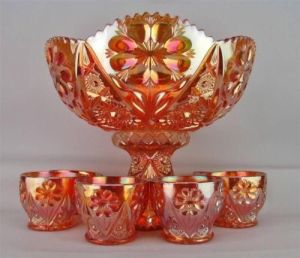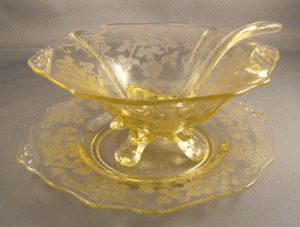What is Carnival Glass and how does it differ from Depression Glass?
Perhaps you’ve just wandered into an estate sale and spotted what you believe to be the most beautiful antique carnival glass you’ve ever seen. How can you be sure it’s genuine? What if it’s depression glass? How can you tell if it’s either, so you know what you’re buying?
At first glance, you might make a quick determination based on the piece’s appearance. If it’s multicolored, chances are you’ve found some “Poor Man’s Tiffany,” or carnival glass. If it is made of one color and appears transparent, it’s likely depression glass. Though there are more specific differences we will later discuss in detail, the two types of glass hold very different histories.
Carnival glass was first marketed in the early 1900’s, with its popularity fading in the roaring 20’s. As the popularity for this glass began to fade, however, depression glass began to become more popular. First marketed in 1923, it continued to be produced until the 1940’s. Strangely enough, carnival glass, despite its fading popularity, stayed in production until the 40’s also.

CLICK HERE for further examples of Orange Carnival Glass
This explains one of the many reasons some are unable to distinguish the two without research. A large volume of the two types of pieces were produced during the same time frame, reflecting similar trending styles of their time. Some people who collected one type also collected the other, so they are often seen together at estate sales, markets and especially antique shops. Some pieces are quite valuable in relation to their original purchase price, worth hundreds or thousands of the mere one dollar bills once used to purchase them new. So, where do you begin on your journey to discover the potential of this beautiful mystery glass you’ve found? Here are some tips:
Both pieces are usually brightly colored :
- If you find multi-colored glass with a “Tiffany-like” appearance, it’s likely carnival glass. This glass was produced to look similar to Tiffany’s, without the high cost.
- If the piece appears iridescent, it’s likely carnival glass
- As a general rule, depression glass appears simpler and usually only consists of one color
- Though both were often given away as free gifts or promotions, they served very different purposes. Carnival glass was originally given away at carnivals. Because of this, most of the pieces were of decorative nature (vases, decorative bowls and beverage pieces)
- Depression glass was intended to be used for table settings. Though some of the pieces were given away with purchases, etc., the remainder of the set could then be purchased by mail. Odds are, if it’s strictly decorative, it’s carnival glass. If it appears to be part of a place setting, it’s likely depression glass.
- The color says it all. Depression glass wasn’t always colored (meaning some of it is simply white), but it also was produced in pink, purple, blue, red, green, yellow or amber. Carnival glass was usually produced in blue, green and orange. If you find a purple piece for example, but it’s iridescent, it’s likely a recent reproduction of carnival glass, NOT depression glass.
- Copies do exist of both, and these copies may not have much value. It’s important to closely examine any markers or indications of age that can help you identify the time period it was produced.
Carnival Glass – Then and Now
The production of this eye-catching glassware began in 1907 by Fenton Glass Company. Originally called “iridescent ware,” its makers had hoped the product would provide an affordable competition to Tiffany and Steuben, allowing housewives to furnish their homes without spending large amounts of money. It did not sell as they hoped, however, but the glass soon found a new booming market: carnivals. Because the glass was so cheaply produced, it could be given away to attract business. It was most commonly awarded to prize winning carnival lovers, although some makers of the glass provided the glass to its customers in hopes of retaining their business.
Carnival glass was produced by a variety of companies in a few different ways, but today the most sought after pieces were finished by hand. The glass was given its unique look by applying a metallic salt spray to a hot, freshly pressed glass piece. After the spray was applied, the glass was then fired again.
Makers and Markings
The following companies produced authentic carnival glass, and some pieces are actually marked accordingly. The absence of a mark does NOT mean the piece isn’t authentic, but it is a good indicator of authenticity when you are uncertain. Marked pieces are generally, though not always, more desirable. This list is not exhaustive.
- Imperial: This is an example of a company who rarely marked its work. Some, however, may have a “NUCUT,” “NUART,” or “IMPERIAL” marking. The Imperial mark is often written in a cross shape.
- Heisey: A rare maker of carnival, these pieces will be marked with an “H” surrounded by a diamond shape.
- Cambridge: This company marked the glass they produced with the words “NEAR CUT” stamped on top of each other.
- Northwood: The most frequently seen carnival marking, an underlined and circled letter “N,” was stamped on pieces produced by this company. A lack of marking is quite common among Northwood pieces, however, and the markings have little to no effect on the product’s current desirability.
Depression Glass – Then and Now
Depression glass was distributed throughout the United States and Canada as a type of promotional offer to increase sales. One could walk into a gas station or grocery store and receive a piece of a place setting for free with a purchase. After a few visits, housewives often had somewhat of a collection, and could order the remainder of their set via mail. In 1934, one could purchase a can of Crystal Wedding Oats and receive a free piece of depression glass, for example.
Before 1920, most glass that was produced was crystal, limiting ownership to those who had disposable income. After the roaring 20’s came about, however, people began to love the variety of color being produced among glass makers. Only certain artisans could create pieces with color since the methods were fairly new, and this may, in part, explain the reason so many desire to collect the pieces today.
Depression glass also offered a way for “common people” to have dinners on plates they adored. Its color served as a metaphor for the hope of better times ahead. After all, during the Great Depression, common people held on to money quite tightly and had little to no money for luxury items. The fact that most of a full set of depression glass could be obtained for free and the rest often for pennies, was a glimmer of hope that every day people could have things they enjoyed, despite hard times.

CLICK HERE for further examples of Yellow Depression Glass
Makers and Markings
Depression glass often has numerous flaws due to its cheap production at the time. Mold marks, air bubbles and ripples were the result of the older molds used at the time. If one were to run her fingernail around the rim of a piece, she would likely feel imperfections such as bumps and other imperfections. However, if one notices a dip in the glass, it should be examined to see if it is a chip or an expected imperfection. Though the glass is often reproduced, it’s important to note that reproductions generally do not display these imperfections, and are not collected or appreciated in the same way. The imperfections are a sign of authenticity, and they do not diminish the value of the glass in any way. In fact, it is quite common to see two of the same pieces with completely different dimensions.
Most depression glass was unmarked, as dozens and dozens of companies produced the products. The best way to determine more information about a piece of depression glass is to research who produced the pattern. From 1923 to the mid 1940’s, Federal Glass Company, Hazel-Atlas Glass Company, Hocking Glass Company, Indiana Glass Company, Jeanette Glass Company, MacBeth-Evans Glass Company and U.S. Glass all were major producers of depression glass.
Throughout the years, collectors have adored these pieces for various reasons from childhood reminiscing, to simply their beauty. What once was a sparkling moment of hope for our grandparents has now become a way that we remember them. Many of us walk into antique stores, glancing around at items worth a year’s salary, but we often are the most distracted by those that remind us of home, our youth, or the happy memories we shared with previous generations. Carnival glass, as well as Depression glass, become more rare each day, and they offer us a glimpse into the past when something so simple meant so much.




